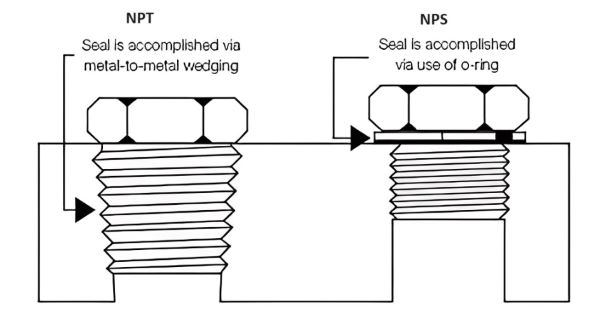Ever needed to connect two pipes with different thread types? NPSM to NPT adapters are your solution. These essential components bridge the gap between NPSM (National Pipe Straight Mechanical) and NPT (National Pipe Tapered) threads, ensuring seamless connections in plumbing systems.
This guide explores NPSM to NPT adapters, their functions, types, and applications. We’ll highlight the differences between NPSM and NPT threads, explain why adapters are necessary, and offer tips on selecting the right adapter and troubleshooting common issues.
What are NPSM and NPT Threads?
Before diving into the world of adapters, let’s clarify what NPSM and NPT threads actually are.
➡️ NPSM stands for National Pipe Straight Mechanical. These threads are parallel, meaning they maintain a constant diameter along their length. They are typically used in applications where a mechanical seal is required, such as those involving gaskets or O-rings.
➡️ NPT stands for National Pipe Tapered. Unlike NPSM, NPT threads have a tapered profile, which creates a tighter seal as the pipe is tightened. They are commonly used in plumbing and hydraulic systems.
Why Is There a Need for NPSM to NPT Adapters?
Given the distinct characteristics of NPSM and NPT threads, it’s clear that they aren’t directly compatible. This incompatibility often poses a challenge when connecting different piping systems. This is where NPSM to NPT adapters come to the rescue. These adapters bridge the gap between the two thread types, enabling seamless connections.
Understanding NPSM and NPT Threads
To fully appreciate the role of adapters, it’s essential to understand the intricacies of both thread types.
➡️ NPSM Threads:
1. Characteristics: Parallel threads, mechanical seal, coarser than NPT threads.
2. Applications: Commonly used in industrial and commercial settings where a reliable seal is required without relying solely on thread engagement.
3. Common misconceptions: Often confused with NPT threads due to similar naming conventions.
➡️ NPT Threads:
1. Characteristics: Tapered threads, self-sealing, finer pitch than NPSM threads.
2. Applications: Widely used in plumbing, hydraulics, and compressed air systems.
3. Common misconceptions: Sometimes assumed to be stronger than NPSM threads, but this isn’t always the case.
➡️ Key Differences:
The primary differences between NPSM and NPT threads lie in their thread profile and sealing mechanism. NPSM threads rely on a mechanical seal, while NPT threads create a seal through their tapered design. This fundamental difference necessitates the use of adapters for compatibility.
The Role of NPSM to NPT Adapters
NPSM to NPT adapters act as transitional components, allowing you to connect pipes or fittings with different thread types. These adapters are typically made with one end featuring NPSM threads and the other with NPT threads.
➡️ Types of NPSM to NPT Adapters
There are several types of NPSM to NPT adapters available:
1. Straight adapters: Connect pipes of the same size but with different thread types.
2. Reducing adapters: Connect pipes of different sizes while also converting thread types.
3. Coupling adapters: Join two pipes of the same size and thread type, but with different end connections (e.g., male-female).
➡️ Materials:
NPSM to NPT adapters are commonly made from brass, stainless steel, or galvanized steel. The choice of material depends on the specific application and the environment in which the adapter will be used.
Choosing the Right NPSM to NPT Adapter
Selecting the correct NPSM to NPT adapter is crucial for ensuring a secure and leak-free connection. Consider the following factors:
1. Pipe size: Ensure the adapter matches the pipe diameters you’re connecting.
2. Material: Choose a material compatible with the fluids or gases being transported.
3. Pressure rating: Select an adapter that can withstand the operating pressure of your system.
4. Application: Consider the specific requirements of your project, such as temperature, vibration, or chemical exposure.
➡️ Determining Adapter Size:
The size of the adapter is typically specified by the pipe size. For example, a ½” NPSM to NPT adapter will connect a ½” NPSM pipe to a ½” NPT pipe.
➡️ Installation Tips:
1. Apply Teflon tape or pipe sealant to the NPT threads for a better seal.
2. Hand-tighten the adapter before using a wrench to avoid damaging the threads.
3. Avoid excessive force during installation.
Troubleshooting Common Issues
Despite careful selection and installation, issues can arise.
1. Leakage: Check for proper thread engagement, tighten the connection (without overtightening), and inspect for damaged threads.
2. Thread damage: Prevent damage by using appropriate tools and avoiding excessive force.
3. Adapter compatibility: Ensure the adapter is compatible with the pipe materials and fluids involved.
Conclusion
Understanding the differences between NPSM and NPT threads is essential for selecting the right adapter. By following the guidelines outlined in this guide, you can confidently connect pipes with varying thread types.
Remember, if you encounter persistent issues, consulting with a plumbing or piping professional is always recommended.
Post time: Aug-08-2024


